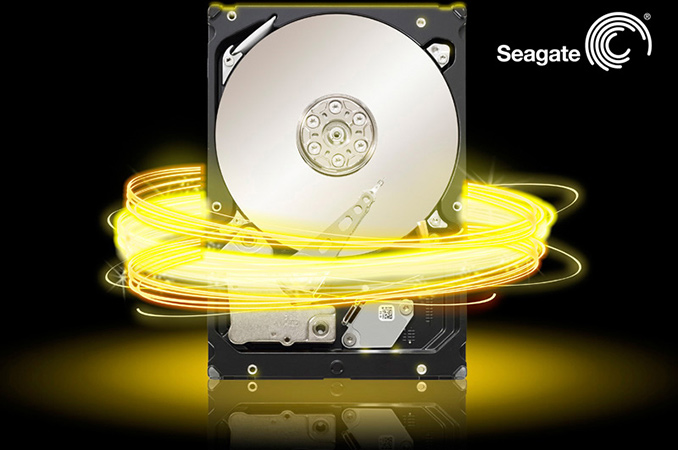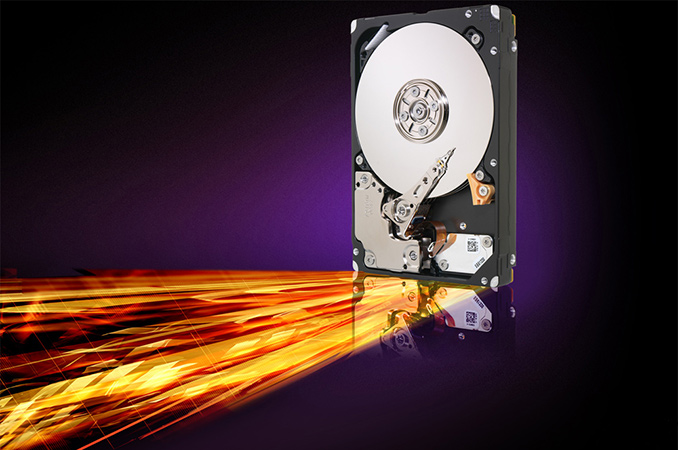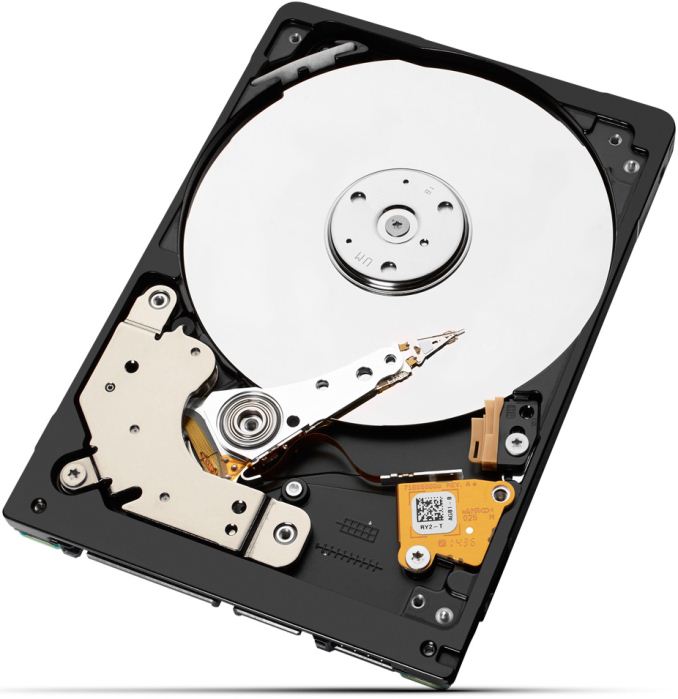Seagate Confirms Plans for 12 TB HDD in Near Future, 16 TB HDD Due in 2018
by Anton Shilov on January 30, 2017 2:00 PM EST
The CEO of Seagate has confirmed plans to release new nearline harddrives with 12 TB capacity in the coming months, and HDDs with 16 TB capacity over the course of the next several quarters. The latter are believed to be based on HAMR technology and the comment by the CEO essentially means that the company is on track with its next generation of heat assisted magnetic recording technology.
12 TB HDDs Incoming
Seagate’s CFO confirmed plans to release nearline HDDs with 12 TB capacity in early November, 2016. Last week Steve Luczo, CEO of Seagate, said that such drives had been evaluated by the company’s customers for about two quarters now and the feedback about the drives had been positive. He did not elaborate on the exact launch timeframe for the product, but given the fact that the drive is nearly ready, it is logical to assume that the 12 TB HDD should be announced formally in the coming weeks or months.
The hard drive maker has not revealed many details about its 12 TB Nearline HDD so far, but previously Seagate disclosed that this drive is filled with helium and is based on PMR technology, whereas last week the company implied that it uses eight platters. Keeping in mind that Showa Denko recently launched 1.5 TB platters for 3.5” drives, it is likely that Seagate uses eight of such platters for its 12 TB HDDs. In fact, Western Digital’s HGST Ultrastar He12 HDD with 12 TB capacity introduced last December comes with eight PMR disks as well.
“As you know, going from 8 to 10 to 12 to 16 [TB], you are going from six to eight disks, at least, on the nearline products,” said Steve Luczo, CEO of Seagate, during a conference call with investors and financial analysts.
16 GB HAMR HDDs in 12 to 18 Months
The 12 GB drive will be Seagate’s top-of-the-range model for enterprise and other demanding applications for quite a while and will become the company’s highest-capacity PMR-based drive. But, for the second time last week, the company mentioned 16 TB HDDs due in the next 12 to 18 months. Moreover, since such drives will be based on HAMR technology (Seagate discussed the feasibility of HAMR-based HDDs at 16 TB last year), they will cause a certain level of disruption on the market.
“During the next 12 to 18 months, we expect the nearline market to be diversified in capacity points for different application workloads, with use cases from 2 to 4 TB products for certain applications up to 16 TB for other use cases,” said Mr. Luczo.
Hard drives featuring heat-assisted magnetic recording technology will cost more to build compared to traditional HDDs because of the increased number of components and use of new materials. As a result, such drives will also be more expensive to actual customers. At present, we do not know specifics, but what Seagate says is that in the future the market of nearline HDDs will get more diverse and its lineup will get wider. In the past, the product stack used to remained similar, and as larger drives were introduced every year, previous-gen products were moved down the stack and low-capacity models discontinued. This may not be the case in the future and customers who need maximum capacity (i.e., who would like to store 3840 TB of data per rack and require 16 TB drives) in 2018 will probably have to pay more than they pay for leading edge HDDs today.
It is noteworthy that Seagate also mentioned 14 TB and 20 TB HDDs in the conference call, but without specifics, it does not sound like a good business to make assumptions about them. So far, the company has not explicitly announced any plans to release SMR-based 14 TB HDDs for specific workloads to compete against Western Digital’s Ultrastar He14.
Higher-Capacity Consumer Drives In Demand
Moving on with the comments made by the head of Seagate, we noticed that Mr. Luczo also mentioned higher-capacity HDDs for consumer applications. In particular, when talking about increasing amount of disks and heads per drive, CEO of Seagate indicated that the numbers are also increasing for consumer HDDs as well.
“We do think there [are] opportunities for more heads and disks on desktop and notebook, as people need higher capacity as well,” said Steve Luczo.
Keeping in mind that Seagate currently offers BarraCuda Pro desktop HDDs with 6 TB, 8 TB and 10 TB drives for consumers, and these drives use enterprise-class platforms (albeit with multiple changes). The remark by the CEO is an indication that the company will keep doing so in the future. Meanwhile it is interesting to note that the head of Seagate also mentioned mobile drives with increased number of platters and heads, hinting on increasing demand for higher-end 2.5” HDDs with more than one platter. At present, Seagate offers 5TB drives in a 2.5-inch form factor, although these come in at 15mm and typically tend not to fit in most mobile environments.
Related Reading:
Source: Seagate
















31 Comments
View All Comments
Michael Bay - Monday, January 30, 2017 - link
I sure hope they manage to hold on just enough to give me one or two of those 20 TB models!And they`ve bought some SSD expertise too.
emn13 - Monday, January 30, 2017 - link
zipdrives aren't a great analogy, because zip drives (as a storage medium with greater capacity than floppies) had multiple plausible competitors - ironically HDDs (with the internet) were one of them.Modern large HDDs aren't a great niche, but I don't see the alternatives either. SSDs are much more expensive and likely to stay so for a while - so what else are you going to use for bulk storage? Tapes?
Sure, eventually SSDs may drop to competitive prices, but by comparison zip drives where a much trickier proposition: the alternatives were cheaper (per storage), although they did require a change in habits.
Heck, with an external bay you could use plain old 2.5" drives as kind of zipdrive today.
dgingeri - Monday, January 30, 2017 - link
What's needed for bulk storage these days? We have many cloud storage providers for documents, from Dropbox to OneDrive. Music and movies are now typically watched through streaming services, so there's no need for huge repositories for media files. Nearly all programs and drivers are immediately downloadable, so there's no need to go store those anymore. What's left? What do we need to store anymore?LordanSS - Monday, January 30, 2017 - link
Those that rely only on the Internet for such things suffer heavily when their connection fails.Absurd majority of the whole world does not have reliable internet services. HDDs are not going away anytime soon.
Concillian - Monday, January 30, 2017 - link
Umm... you ask what's needed for bulk storage these days, then literally rattle off half a dozen applications that require huge quantities of large capacity and high reliability HDDs.End users may not be the primary customers for huge capacity HDDs, but as long as places like Dropbox and Netflix exist, and HDDs are lower total cost of ownership than SSDs, there will be plenty of demand for high capacity HDDs.
dgingeri - Tuesday, January 31, 2017 - link
Big business is moving to flash storage instead of hard drives for performance reasons. With some storage situations, such as user documents, the larger the repository, the more efficient deduplication can be, and thus cheaper and faster storage is through systems with lots of memory and flash and far less HD storage. Even with Netflix and Hulu, flash storage is far better because they can serve more systems from the same storage. A single movie in flash storage can be served out to a hundred people at once, while ten sets of HD RAIDs would be needed to serve the same customers, simply because of the IOPS. Then take corporate backups to the "cloud". Flash storage is much better for that, in combination with deduplication, as the performance is much better over the internet. Trying to use rotational storage for cloud backups increases the latency far too much, and the backups get horrible performance, leaving the overnight backup taking several hours into the work day. Flash comes out cheaper, across the board.HD storage is going down, fast. It just isn't fast enough anymore.
ddriver - Monday, January 30, 2017 - link
For porn, when the internet is off.close - Tuesday, January 31, 2017 - link
Even if relying on an internet connection wasn't bad (it is) where do you think your data sits when it's "in the cloud"? Well I can tell you it's not in an actual cloud :). It's on HDDs like these because "the cloud" needs to store as much data in as little (physical) space as possible to save costs.That's why these offerings come first in Enterprise models (https://www.hgst.com/products/hard-drives/ultrasta... and then trickle down in the consumer space as it gets cheaper.
Plenty of people need to store TBs of audio/video data or virtual machines just to give a few examples. It's not only a matter of privacy but until the internet link is as fast and reliable as a SATA cable the two solutions will simply complement each other.
dgingeri - Tuesday, January 31, 2017 - link
I'm well aware that "cloud" is just another term for "someone else's" redundant storage or computer system. However, most cloud storage these days is moving to flash, either over SAS, FCoE, or iSCSI, and is set to duplicate across the internet to other systems. Rotational storage for that use is just not fast enough in IOPS to work well enough.I know this because I used to work for a storage company, Quantum. Their business is lagging badly. the only thing keeping them going at this point is government contracts, where it takes an act of Congress to make any changes.
Rotational storage for internet reasons is dying faster than home user storage. Even for home users, the most used is flash drives, and they're getting big enough that people don't need the internal storage for most things.
Rotational storage is dying. Let it die.
close - Wednesday, February 1, 2017 - link
You have a terribly odd reasoning for a person claiming to have worked in the field. Then again you don't say what you were doing there so... First of all you completely ignore the cost per GB for all flash storage, then you say that the technology should die because it's not the best at everything anymore.If all storage was flash you wouldn't afford your current cloud storage. And if only the products that are best at everything would be allowed to "live" I don't even know where you'd be... Not here anyway.
Rotational storage doesn't work "well enough"? For who? For what? Maybe you should have worked for an argumentation company. It may not have more than a few years ahead of it but as long as it offers more GBs for the same buck it will chug along just fine.
Someone should tell Ford, GM, or Toyota to roll over and die because Ferrari makes faster cars. I know because I worked in a car dealership...